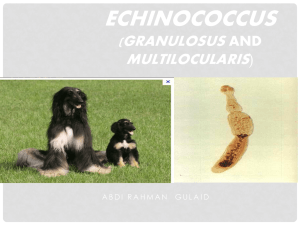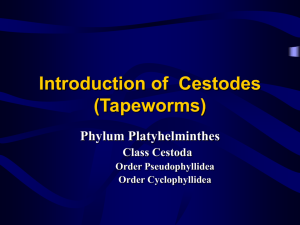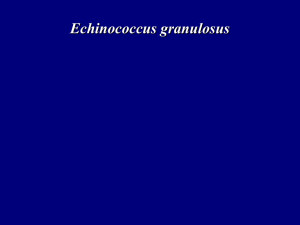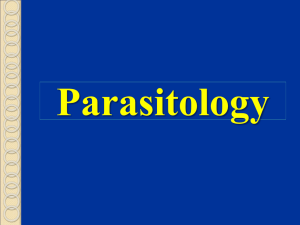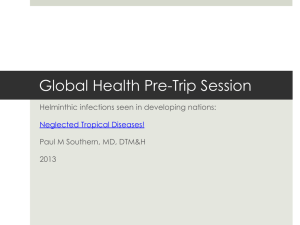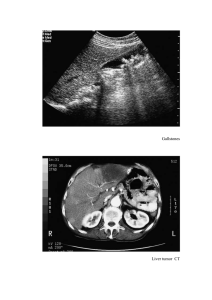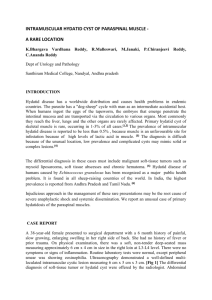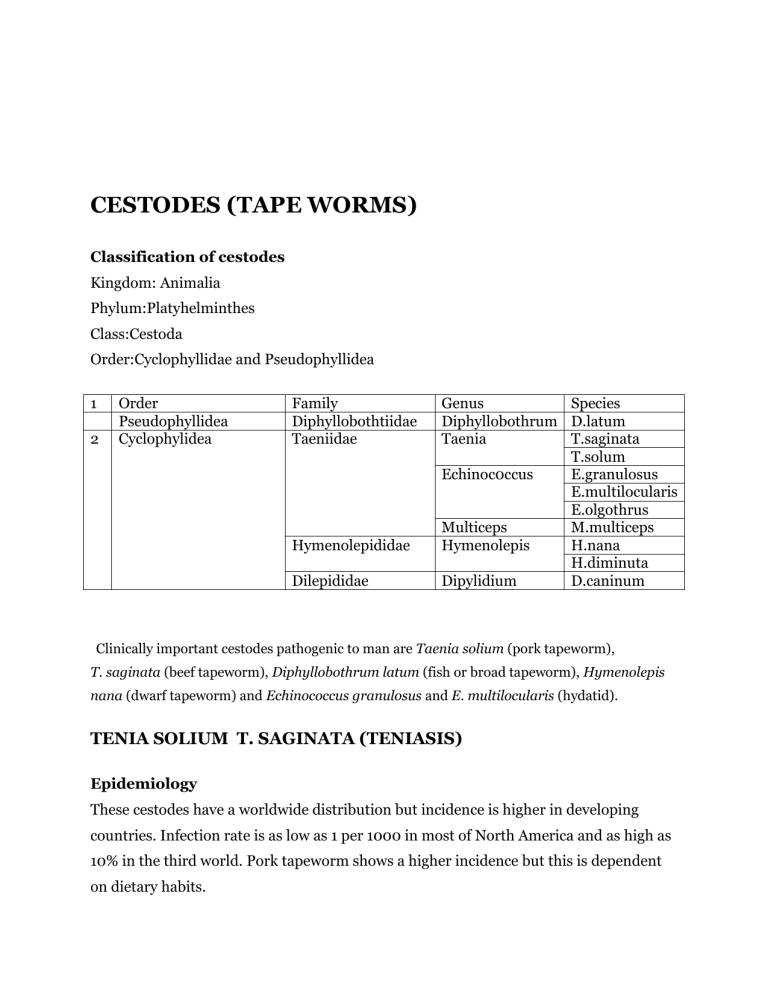
CESTODES (TAPE WORMS) Classification of cestodes Kingdom: Animalia Phylum:Platyhelminthes Class:Cestoda Order:Cyclophyllidae and Pseudophyllidea 1 2 Order Pseudophyllidea Cyclophylidea Family Diphyllobothtiidae Taeniidae Hymenolepididae Dilepididae Genus Species Diphyllobothrum D.latum Taenia T.saginata T.solum Echinoc0ccus E.granulosus E.multilocularis E.olgothrus Multiceps M.multiceps Hymenolepis H.nana H.diminuta Dipylidium D.caninum Clinically important cestodes pathogenic to man are Taenia solium (pork tapeworm), T. saginata (beef tapeworm), Diphyllobothrum latum (fish or broad tapeworm), Hymenolepis nana (dwarf tapeworm) and Echinococcus granulosus and E. multilocularis (hydatid). TENIA SOLIUM T. SAGINATA (TENIASIS) Epidemiology These cestodes have a worldwide distribution but incidence is higher in developing countries. Infection rate is as low as 1 per 1000 in most of North America and as high as 10% in the third world. Pork tapeworm shows a higher incidence but this is dependent on dietary habits. Morphology T. saginata can be up to 4 to 6 meters long and 12 mm broad; it has a pear-shaped head (scolex) with four suckers but no hooks or neck. It has a long flat body with several hundred segments (proglottids). Each segment is about 18 x 6 mm with a branched uterus (15-30 branches). The egg is 35 x 45 micrometers, roundish and yellow-brown. It has peripheral radial striations and contains an embryo with 3 hooklets (figure 2). T. solium is slightly smaller than T. saginata. It has a globular scolex with four suckers and a circular row of hooks (rostellum) that gives it a solar appearance. There is a neck and it has a long flat body (0.1 meter in length). The proglottids are 5 x 10 mm with a 712 branch uterus. The eggs of T. solium and T. saginata are indistinguishable Life cycle of Taenia saginata and Taenia solium Humans are the only definitive hosts for Taenia saginata and Taenia solium. Eggs or gravid proglottids are passed with feces; the eggs can survive for days to months in the environment. Cattle (T. saginata) and pigs (T. solium) become infected by ingesting vegetation contaminated with eggs or gravid proglottids. In the animal's intestine, the oncospheres hatch, invade the intestinal wall, and migrate to the striated muscles, where they develop into cysticerci. A cysticercus can survive for several years in the animal. Humans become infected by ingesting raw or undercooked infected meat. In the human intestine, the cysticercus develops in 3 to4 months into an adult tapeworm, which can survive for 25 years. The adult tapeworms attach to the small intestine by their scolex and reside in the small intestine. Length of adult worms is usually 5 m or less for T. saginata (however it may reach up to 25 m) and 2 to 7 m for T. solium. The adults produce proglottids which mature, become gravid, detach from the tapeworm, and migrate to the anus or are passed in the stool (approximately 6 per day). T. saginata adults usually have 1,000 to 2,000 proglottids, while T. solium adults have an average of 1,000 proglottids. The eggs contained in the gravid proglottids are released after the proglottids are passed with the feces. T. saginata may produce up to 100,000 and T. solium may produce 50,000 eggs per proglottid respectively Cysticercosis T. solium eggs can also infect humans and cause cysticercosis (larval cysts in lung, liver, eye and brain) resulting in blindness and neurological disorders. The incidence of cerebral cysticercosis can be as high 1 per 1000 population and may account for up to 20% of neurological case in some countries (e.g., Mexico); cysticercosis ocular involvement occurs in about 2.5% of patients and muscular involvement is as high as 10% (India). Pathogesis Light infections remain asymptomatic, but heavier infections may produce abdominal discomfort, epigastric pain, vomiting and diarrhea. Gastrointestinal symptoms are due to the presence of the tape worm. Cysticercosis symptoms are a result of inflammatory/immune responses. Antibodies are produced in cysticercosis and are useful epidemiological tools. Diagnosis Diagnosis is based on the recovery of eggs or proglottids in stool or from the perianal area. Cysticercosis is confirmed by the presence of antibodies. Figure 2A Figure 2B Figure 2C Figure 2D Taenia saginata gravid proglottid © Dr Peter Darben, Queensland University of Technology clinical parasitology collection. Used with permission Taeniid eggs. The eggs of Taenia saginata and T. solium are undistinguishable morphologically (morphologic species identification will have to rely on the proglottids or scolices). The eggs are rounded or subspherical, diameter 31 - 43 µm, with a thick radially striated brown shell. Inside each shell is an embryonated oncosphere with 6 hooks. The egg in B still has the primary membrane that surrounds eggs in the proglottids. CDC Taenia solium cysticercus, whole and in section of muscle (H&E) © Dr Peter Darben, Queensland University of Technology clinical parasitology collection. Used with permission Gravid proglottids of (left) Taenia saginata and (right) T. solium. Injection of India ink in the uterus allows visualization of the primary lateral branches. Their number allows differentiation between the two species: T. saginata has 15 - 20 branches on each side, while T. solium has 7 13. Note the genital pores in mid-lateral position. CDC Figure 2E Figure 2F Figure 2G Figure 2G Taenia sp. egg Taenia solium scolex and gravid proglottid Scolex of Taenia solium. Histopathology of Taenia saginata in appendix. CDC © Dr Peter Darben, Queensland University of Technology clinical parasitology collection. Used with permission © Dr Peter Darben, Queensland University of Technology clinical parasitology collection. Used with permission CDC/Dr. Mae Melvin Treatment and control Praziquantel is the drug of choice. Expulsion of scolex must be assured to assume a satisfactory treatment. A thorough inspection of beef and pork, adequate cooking or freezing of meat is effective precautions, since cysticerci do not survive temperatures below -10o C and above 50o C. ECHINOCOCCOSIS (HYDATID) Echinococcus granulosus and E. multilocularis are causative agents of hydatid cysts. Epidemiology Hydatid disease is known to occur in many parts of the world where sheep are in close association with dogs and humans or where dogs and wild carnivores are associated with livestock and wild herbivores. High infection rates occur in China, East Africa (especially the Turkana region in Kenya), North Africa, South Africa, India, Nepal, eastern Mediterranean, Middle East, and parts of South America, and Australasia Morphology This is the smallest of all tapeworms (3 to 9 mm long) with only 3 proglottids. The adult Echinococcus granulosus (3 to 6 mm long),resides in the small bowel of the definitive hosts, dogs or other canids. Life cycle: Gravid proglottids release eggs that are passed in the feces. After ingestion by a suitable intermediate host (under natural conditions: sheep, goat, swine, cattle, horses, camel), the egg hatches in the small bowel and releases an oncosphere that penetrates the intestinal wall and migrates through the circulatory system into various organs, especially the liver and lungs. In these organs, the oncosphere develops into a cyst that enlarges gradually, producing protoscolices and daughter cysts that fill the cyst interior. The definitive host becomes infected by ingesting the cyst-containing organs of the infected intermediate host. After ingestion, the protoscolices evaginate, attach to the intestinal mucosa, and develop into adult stages in 32 to 80 days. The same life cycle occurs with E. multilocularis (1.2 to 3.7 mm), with the following differences: the definitive hosts are foxes, and to a lesser extent dogs, cats, coyotes and wolves; the intermediate host are small rodents; and larval growth (in the liver) remains indefinitely in the proliferative stage, resulting in invasion of the surrounding tissues. With E. vogeli (up to 5.6 mm long), the definitive hosts are bush dogs and dogs; the intermediate hosts are rodents; and the larval stage (in the liver, lungs and other organs) develops both externally and internally, resulting in multiple vesicles. E. oligarthrus (up to 2.9 mm long) has a life cycle that involves wild felids as definitive hosts and rodents as intermediate hosts. Humans become infected by ingesting eggs, with resulting release of oncospheres in the intestine and the development of cysts in various organs Pathogenesis The symptoms, comparable to those of a slowly growing tumor, depend upon the location of the cyst. Large abdominal cysts produce increasing discomfort. Liver cysts cause obstructive jaundice. Peribronchial cysts may produce pulmonary abscesses. Brain cysts produce intracranial pressure and Jacksonian epilepsy. Kidney cysts cause renal dysfunction. The contents of a cyst may produce anaphylactic responses. Diagnosis Clinical symptoms of a slow-growing tumor accompanied by eosinophilia are suggestive. Intradermal (Casoni) test with hydatid fluid is useful. Pulmonary cysts and calcified cysts can be visualized using x-rays. Antibodies against hydatid fluid antigens have been detected in a sizable population of infected individuals by ELISA or indirect haemagglutination test. Figure 8A Figure 8B Figure 8C Figure 8D "Hydatid sand". Fluid aspirated from a hydatid cyst will shows Echinococcus granulosus egg © Dr multiple protoscolices Peter Darben, Queensland (size approximately University of Technology 100 µm), each of which clinical parasitology collection. Used with has typical hooklets. permission The protoscolices are normally invaginated (left), and evaginate (middle, then right) when put in saline. CDC Echinococcus granulosus adult © Dr Peter Darben, Queensland University of Technology clinical parasitology collection. Used with permission Echinococcus granulosus hydatid cysts in section of lung (H&E) © Dr Peter Darben, Queensland University of Technology clinical parasitology collection. Used with permission Image contributed by Georgia Division of Public Health Figure 8E Figure 8F Figure 8G Figure 8F Echinococcus granulosus hydatid sand © Dr Peter Darben, Histopathology of hydatid cyst. Echinococcus, echinococcosis, Hydatid cysts Gross pathology of cotton rat infected with Echinococcus multilocularis. First E. locularis isolated in the United States proper. Queensland University of Technology clinical parasitology collection. Used with permission CDC/Dr. Mae Melvin CDC/Dr. I. Kagan Figure 8G Figure 8H Figure 8I Histopathology of Echinococcus granulosus hydatid cyst in a sheep. Thick fibrous pericyst, hyaline ectocyst, and brood capsules filled with protoscolices are visible. CDC/Dr.Peter Gross pathology of membrane and hydatid daughter cysts from human lung CDC/Dr. I. Man's arm showing positive skin test for hydatid disease (echinococcosis) CDC/Dr. Schantz Kagan I. Kagan Treatment and control Treatment involves surgical removal of cyst or inactivation of hydatid sand by injecting the cyst with 10% formalin and its removal within five minutes. It has been claimed that a high dose of Mabendazole results in some success. Preventive measures involve avoiding contact with infected dogs and cats and elimination of their infection. E. MULTILOCULARIS. Infections have been reported mainly from Canada, Alaska, USSR and Europe. This is a tapeworm, similar to E. granulosus, that also causes hydatid in northern parts of Asia and North America. It has a very similar morphology and life cycle except that rodents are its intermediate host. Pathogenesis Humans, when infected with this worm, also develop hydatid cysts which produce symptoms similar to those caused by E. granulosus. However, the cysts are multilocular (many chambers). The hydatid cyst of E. multilocularis is invasive and spreads like a malignant tumour causing cavities and necrosis. It is not encapsulated like the hydatid cyst of E. granulosus. The liver is commonly infected. Treatment The organism is resistant to Praziquantel; high doses of Albendazole has some antiparasitic effect. Surgical removal is rarely possible and the disease is usually fatal. Rodent control is the means of prevention. MULTICEPS SPECIES The larval stage of these tapeworm species is a coenurus cyst and human infection with the larva is referred to as coenuriasis. Infection occurs following the ingestion of eggs in food or from hands contaminated with dog faeces. Multiceps multiceps is found in North and South Africa and the coenurus infects the brain. There is no treatment and infection is usually fatal. Multiceps brauni is found in tropical Africa and causes a less serious disease because the coenurus does not infect the brain. The eyes and other parts of the body are infected. The definitive hosts of Multiceps species are dogs and jackals. The intermediate hosts of M. multiceps are sheep and the intermediate hosts of M. brauni are rodents.

